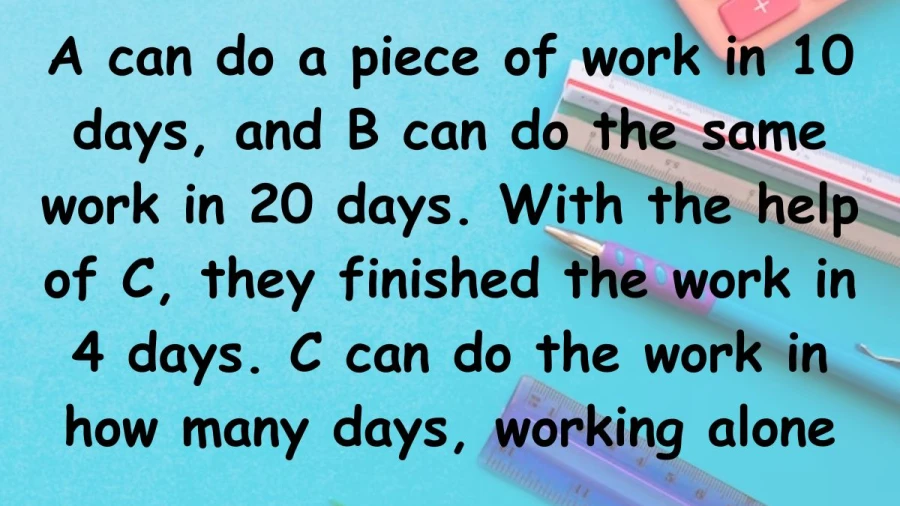If you happen to be viewing the article A can do a piece of work in 10 days, and B can do the same work in 20 days. With the help of C, they finished the work in 4 days. C can do the work in how many days, working alone?? on the website Math Hello Kitty, there are a couple of convenient ways for you to navigate through the content. You have the option to simply scroll down and leisurely read each section at your own pace. Alternatively, if you’re in a rush or looking for specific information, you can swiftly click on the table of contents provided. This will instantly direct you to the exact section that contains the information you need most urgently.
A can do a piece of work in 10 days, and B can do the same work in 20 days. With the help of C, they finished the work in 4 days. C can do the work in how many days, working alone?
C can complete the work alone in 10 days.
To solve this problem, we can first find the individual rates at which each person works, and then use that information to find out how long it would take for C to complete the work alone.
Article continues below advertisement
Let’s denote:
- Rate of A = 1/10 of the work per day
- Rate of B = 1/20 of the work per day
- Rate of C = 1/x of the work per day, where x represents the number of days it takes for C to complete the work alone.
Working together, their combined rate is the sum of their individual rates: Rate when A, B, and C work together = 1/10 + 1/20 + 1/x
Given that they finish the work in 4 days working together, we can set up the equation:
4 * (1/10 + 1/20 + 1/x) = 1
Here, 1 represents the entire work done.
Now, let’s solve for x:
4 * (1/10 + 1/20 + 1/x) = 1 (4/10) + (4/20) + (4/x) = 1 (2/5) + (1/5) + (4/x) = 1 (3/5) + (4/x) = 1 4/x = 1 – (3/5) 4/x = 2/5
Now, cross multiply:
4 * 5 = 2x 20 = 2x x = 20/2 x = 10
So, C can complete the work alone in 10 days.
Time and Work in Mathematics
Time and work problems in mathematics deal with calculating how much work can be done by a person or a group of people in a certain amount of time, or how long it takes for a certain amount of work to be completed based on the rate of work. These types of problems often involve proportions, rates, and the concept of work being a product of time and rate.
Article continues below advertisement
Article continues below advertisement
Here are some common types of time and work problems and their solutions:
-
One-person working alone: If one person can complete a certain task in x hours, then the rate of work of that person is 1/x of the task per hour.
-
Multiple people working together: If n people can complete a task together in x hours, then the combined rate of work of all n people is n/x of the task per hour.
-
Fractional work: If a person completes a fraction of a task per hour, say 1/n, then it takes n hours for that person to complete the entire task.
-
Work completed in part of the time: If a person works for only part of the total time, their work needs to be multiplied by the fraction of time they worked.
-
Inverse proportion: Sometimes, the number of people working together and the time taken to complete a task are inversely proportional. For example, if the number of workers increases, the time taken decreases, and vice versa.
-
Work rates additivity: If two people working together can complete a task in a certain amount of time, then each person’s individual rate of work can be added together to find the combined rate of work.
When solving time and work problems, it’s essential to set up equations based on the given information and then solve for the unknowns using algebraic manipulation or simple arithmetic. It’s also important to pay attention to units and ensure consistency throughout the problem.
Thank you so much for taking the time to read the article titled A can do a piece of work in 10 days, and B can do the same work in 20 days. With the help of C, they finished the work in 4 days. C can do the work in how many days, working alone? written by Math Hello Kitty. Your support means a lot to us! We are glad that you found this article useful. If you have any feedback or thoughts, we would love to hear from you. Don’t forget to leave a comment and review on our website to help introduce it to others. Once again, we sincerely appreciate your support and thank you for being a valued reader!
Source: Math Hello Kitty
Categories: Math

